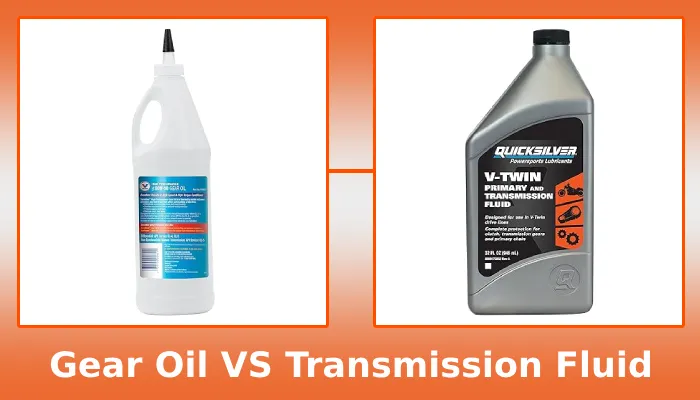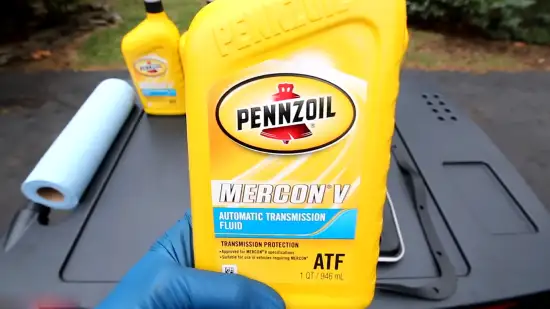Physical Address
304 North Cardinal St.
Dorchester Center, MA 02124
Physical Address
304 North Cardinal St.
Dorchester Center, MA 02124

Gear oil and transmission fluid are both essential components of your vehicle’s drivetrain, each with distinct roles and characteristics. Understanding the differences between them is vital for proper maintenance and ensuring the longevity of your car.
The primary distinction between gear oil and transmission fluid rests in the purpose and application of each. Gear oil is specifically engineered for manual transmissions and differentials, serving as the protective barrier for high-friction components.
In contrast, transmission fluid, often called ATF (Automatic Transmission Fluid), is tailored for automatic transmissions.
Notably, viscosity variance sets these two fluids apart. Gear oil boasts a thick and heavy consistency. In contrast, transmission fluid has a significantly lower viscosity.
We will discuss the differences between gear oil and transmission fluid, helping you make a well-informed decision regarding the lubrication of your vehicle.

Gear oil and transmission fluid may seem similar, but they have distinct differences.
Gear oil is specifically formulated to provide lubrication and protection to the high-friction components found in manual transmissions and differentials. It’s designed to withstand extreme pressures and temperatures, ensuring smooth gear shifting and reducing wear and tear on the gears.
In contrast, transmission fluid, also known as ATF, is primarily used in automatic transmissions. Its main purpose is to lubricate and cool the intricate components within the transmission, such as the clutch packs and torque converter. Further, it provides hydraulic pressure to ensure smooth and efficient gear shifting.
Regarding the viscosity variance between gear oil and transmission fluid, you’ll notice distinct differences in their thickness and flow characteristics.
Gear oil is designed to be thicker and heavier in consistency, featuring viscosity ratings such as 70/80W-90 or even as high as 140 weight. This high viscosity is crucial for effectively lubricating and cushioning gears, providing them with the necessary protection against damage.
On the other hand, transmission fluid has a much lower viscosity, typically ranging from 0W-30/40. The lower viscosity of transmission fluid is essential for the smooth operation of automatic transmissions, allowing it to flow more freely and efficiently through the transmission system.
Gear oil contains enhancing additives such as corrosion inhibitors, antifoam agents, and antioxidants. These additives protect metal components from rust and corrosion, prevent foam formation, and extend the shelf life of the oil by preventing oxidation.
This oil also includes imparting additives like metal deactivators, tackiness agents, and extreme pressure additives.
Meanwhile, transmission fluid (ATF) additives focus on specific issues in automatic transmissions. They include preventatives for fluid loss, impurity prevention agents, temperature control enhancers, oxidation and corrosion inhibitors, transmission wear reducers, and noise and jolt minimizers.
These additives ensure proper lubrication, prevent leaks, maintain cleanliness, regulate temperature, protect against wear, and minimize noise and vibrations during gear changes.
The color of gear oil and transmission fluid is also different. In its new state, Gear oil typically has a light brown color. This light brown hue is a characteristic feature of gear lubricants.
It helps to differentiate gear oil from other types of lubricants used in vehicles. The light brown color of gear oil is due to the additives and base oils used in its formulation.
Conversely, transmission fluid, also known as ATF (Automatic Transmission Fluid), has a translucent dark red color when it’s fresh. This dark red color is a distinguishing characteristic of transmission fluid in automatic transmissions.
The red color of transmission fluid is a result of the dye added to it during the manufacturing process. This dye makes it easier to identify transmission fluid and helps mechanics and vehicle owners quickly distinguish it from other fluids.
Gear oil and transmission fluid differ in cost. Gear oil prices range from less than $10 to over $500, while transmission fluid prices range from $80 to $250 on average.
The price variation in gear oil is mainly due to the different formulations and performance levels available in the market. High-performance gear oils, such as those used in racing or heavy-duty applications, tend to be more expensive.
Transmission fluid prices, on the other hand, are influenced by factors such as brand, type, and quantity required.
Manual transmissions generally have lower fluid costs compared to automatic transmissions, as they typically require less fluid and don’t require filter replacement.
However, the cost can increase significantly when considering a complete transmission fluid service, which includes flushing and filter replacement.
It’s important to consider these cost differences when selecting the appropriate lubricant for your vehicle’s transmission system.
| Aspect | Gear Oil | Transmission Fluid |
| Purpose and Application | Designed for manual transmissions and differentials. | Primarily used in automatic transmissions. Provides lubrication and cooling for components within automatic transmissions. |
| Viscosity Variance | Thick and heavy consistency, typically with viscosity ratings like 70/80W-90 or even 140 weight. | Significantly lower viscosity, typically ranging from 0W-30/40, to enable smooth operation in automatic transmissions. |
| Additives | Contains corrosion inhibitors, antifoam agents, antioxidants, and suppressing additives such as viscosity index improvers and pour-point depressants. | Includes additives for preventing fluid loss, impurity control, temperature regulation, wear protection, and noise reduction during gear changes. |
| Color | Light brown when new, due to additives and base oils. | Translucent dark red color in its fresh state, distinguished by added dye. |
| Cost | Prices vary widely, ranging from less than $10 to over $500, influenced by formulation and performance levels. | Price range is typically between $80 and $250 for automatic transmissions. Manual transmissions have lower fluid costs but can increase with complete service. |

You should always consult your owner’s manual to determine if automatic transmission fluid can be used in your manual transmission. While it’s possible to use ATF in a manual transmission, it’s crucial to ensure compatibility and follow the manufacturer’s recommendations.
Manual transmissions have specific lubrication requirements that may differ from those of automatic transmissions.
Using the wrong type of fluid can lead to inadequate lubrication, increased wear and tear, and potential damage to the transmission. Some manual transmissions may require gear lube or motor oil instead of ATF.
To ensure optimal performance and protection of your manual transmission, it’s imperative to adhere to the manufacturer’s guidelines and use the recommended lubricant.
When it comes to mixing gear oil or transmission fluid from different brands, it’s generally not recommended due to potential compatibility issues and compromised performance.
Gear oils and transmission fluids are formulated with specific additive packages that are designed to work optimally with their respective systems.
Mixing different brands or types can disrupt the balance of these additives, leading to reduced lubrication and protection for your transmission. Additionally, different fluids may have different viscosities and properties, which can further affect performance.
While it may be tempting to mix fluids if you have leftovers or can’t find the specific fluid you need, it’s a risk that should be avoided. To ensure consistent performance and protection for your transmission, it’s best to stick to a single, compatible brand and type of fluid.
If transmission fluid has deteriorated, its color will change from its original bright red to brown or black. This color transformation is a consequence of oxidation, which significantly diminishes the fluid’s functionality.
Dark brown or black transmission fluid indicates contamination and is no longer capable of providing adequate lubrication to the various components within your transmission. The presence of discolored transmission fluid can lead to damage and a decrease in performance.
To prevent such issues, it’s crucial to regularly replace old transmission fluid that has become discolored. By adhering to proper maintenance practices, you can ensure that your transmission operates optimally and avoid costly repairs in the future.
Both gear oil and transmission fluid play vital roles in your vehicle’s transmission system, but they are distinctly designed to meet the unique demands of manual and automatic transmissions, respectively.
Understanding these differences is essential for maintaining the health and performance of your vehicle. While it’s possible to use automatic transmission fluid in a manual transmission in some cases, always refer to your owner’s manual for guidance.
Additionally, avoid mixing different brands or types of these fluids to prevent compatibility issues.
Regular maintenance, including fluid changes, is key to keeping your transmission in top condition, ensuring smooth gear shifts and prolonging its lifespan.
Last update on 2025-06-30 / Affiliate links / Images from Amazon Product Advertising API